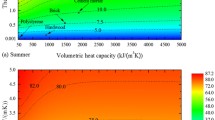Abstract
It is generally accepted that a vapor barrier is necessary to ensure the durability of building envelopes, especially in cold climates where the risk of winter condensation is high. However, the water vapor resistance of the typical vapor barrier —polyethylene foil— is considered by many to be overly high because it also reduces the drying capacity of the envelope. However, installing an excessively permeable vapor barrier could trigger condensation and mold growth. Organic insulation materials could allow reducing the vapor resistance of the vapor barrier in a safer way, as these are more hygroscopic than petroleum-based insulations. This study numerically investigated the risk of condensation and mold growth of three wall assemblies, from which two were insulated with bio-based materials and the other one was a reference standard wall. Hygrothermal simulations considered different levels of permeability of the vapor barrier and ventilation rates in the air gap behind the exterior cladding. Results indicated that walls with bio-insulation materials have the potential to function in a cold climate without triggering mold growth, especially when using a vapor retarder. Ventilation of the exterior air layer proved to be effective when in contact with organic materials, but practically useless otherwise. It was found that the polyethylene foil performed similarly to a smart vapor barrier in all assemblies, except for the highly hygroscopic wall.
Access this chapter
Tax calculation will be finalised at checkout
Purchases are for personal use only
Similar content being viewed by others
References
American Society of Heating, Refrigerating and Air-Conditioning Engineers, 2017 ASHRAE Handbook-Fundamentals, Inch-Pound edition. Atlanta, GA: American Society of Heating, Refrigerating and Air-Conditioning Engineers (2017)
Irbe, I., Andersone, I.: Wood decay fungi in latvian buildings including cultural monuments. In: International Conference held by COST Action IE0601, Braga, pp. 1000–1007 (2010)
Afshari, A., et al.: WHO guidelines for indoor air quality: dampness and mould. Copenhagen, Denmark: World Health Organization (2009)
May, N.: Breathability: The Key to Building Performance, pp. 1–30 (2005)
Lstiburek, J.: Moisture control for buildings, ASHRAE J. 44, 8 (2002)
Simonson, C.J., Salonvaara, M., Ojanen, T.: Heat and mass transfer between indoor air and a permeable and hygroscopic building envelope: part I - field measurements. J. Therm. Envel. Build. Sci. 28(2), 161–185 (2004)
Geving, S., Holme, J.: Vapour retarders in wood frame walls and their effect on the drying capability. Front. Archit. Res. 2(1), 42–49 (2013). https://doi.org/10.1016/j.foar.2012.12.003
Birjukovs, M., Apine, I., Jakovics, A.: Numerical models for long-term performance assessment of lightweight insulating assemblies. In: IOP Conference Series Material Science Engineering, vol. 660, p. 012024 (2019). https://doi.org/10.1088/1757-899X/660/1/012024
Vinha, J.: Analysis method to determine sufficient water vapour retarder for timber-framed walls. In: Proceedings of 8th Symposium Building Physics Nordic Ctries, pp. 1245–1252 (2008)
Rode, C.: Organic insulation materials: effect on indoor humidity and necessity of a vapor barrier. Proc. Therm. Perform. Exter. Envel. Build. 7, 109–121 (1998)
Bastien, D., Winther-Gaasvig, M.: Influence of driving rain and vapour diffusion on the hygrothermal performance of a hygroscopic and permeable building envelope. Energy 164, 288–297 (2018). https://doi.org/10.1016/j.energy.2018.07.195
Padfield, T.: The role of absorbent building materials in moderating changes of relative humidity. The Technical University of Denmark (1998)
Simonson, C.J., Salonvaara, M.H., Ojanen, T.: Moisture content of indoor air and structures in buildings with vapor-permeable envelopes. Perform. Exter. Envel. Whole Build. VIII (2001)
Simonson, C.J., Ojanen, T., Salonvaara, M.: Moisture performance of an airtight, vapor-permeable building envelope in a cold climate. J. Therm. Envel. Build. Sci. 28(3), 205–226 (2005). https://doi.org/10.1177/1097196305048628
Geving, S., Lunde, E., Holme, J.: Laboratory investigations of moisture conditions in wood frame walls with wood fiber insulation. Energy Procedia 78, 1455–1460 (2015). https://doi.org/10.1016/j.egypro.2015.11.170
Karagiozis, A.N., Künzel, H.M.: The effect of air cavity convection on the wetting and drying behavior of wood-frame walls using a multi-physics approach. J. ASTM Int. 6(10), 15 (2009). https://doi.org/10.1520/JAI101455
Künzel, H. M., Zirkelbach, D., Schafaczek, B.: Modelling the effect of air leakage in hygrothermal envelope simulation. In: Proceedings of the Building Enclosure Science & Technology (BEST3) Conference (2012)
Caron-Rousseau, A., Blanchet, P., Gosselin, L.: Parametric study of lightweight wooden wall assemblies for cold and subarctic climates using external insulation. Buildings 12(7), 1031 (2022). https://doi.org/10.3390/buildings12071031
Knarud, J.I., Geving, S.: Comparative study of hygrothermal simulations of a masonry wall. Energy Procedia 132, 771–776 (2017). https://doi.org/10.1016/j.egypro.2017.10.027
Allué Hoyos, C., Vinha, J.: Applicability of COMSOL Multiphysics to combined heat, air and moisture transfer modelling in building envelopes. Master of Science Thesis, Tampere University of Technology, Tampere, Finland (2014)
Fraunhofer Institute for building physics, “WUFI 2D,” WUFI. https://wufi.de/en/software/wufi-2d/. Accessed 02 Dec 2022
Canadian Commission on Building and Fire Codes, National Energy Code of Canada for Buildings: 2020, Fifth Edition. Canada: National Research Council of Canada (2022)
Proclima, Product information about Intello. www.proclima.com Accessed 28 Nov 2022
Rahiminejad, M., Khovalyg, D.: Review on ventilation rates in the ventilated air-spaces behind common wall assemblies with external cladding. Build. Environ. 190, 107538 (2021). https://doi.org/10.1016/j.buildenv.2020.107538
Hukka, A., Viitanen, H.A.: A mathematical model of mould growth on wooden material. Wood Sci. Technol. 33(6), 475–485 (1999). https://doi.org/10.1007/s002260050131
Viitanen, H.: Factors affecting the development of biodeterioration in wooden constructions. Mater. Struct. 27(8), 483–493 (1994). https://doi.org/10.1007/BF02473453
Acknowledgements
The authors are grateful to Natural Sciences and Engineering Research Council of Canada for the financial support through its IRC and CRD programs (IRCPJ 461745–18 and RDCPJ 533629–18) as well as the industrial partner Oïkos Construction of the NSERC industrial chair on eco responsible wood construction (CIRCERB).
Author information
Authors and Affiliations
Corresponding author
Editor information
Editors and Affiliations
Rights and permissions
Copyright information
© 2023 The Author(s), under exclusive license to Springer Nature Switzerland AG
About this paper
Cite this paper
Delgadillo Buenrostro, L., Gosselin, L., Blanchet, P. (2023). Numerical Investigation of Mold Growth Risk in Vapor-Permeable Building Envelopes with Bio-Based Insulation in Cold Climates. In: Amziane, S., Merta, I., Page, J. (eds) Bio-Based Building Materials. ICBBM 2023. RILEM Bookseries, vol 45. Springer, Cham. https://doi.org/10.1007/978-3-031-33465-8_53
Download citation
DOI: https://doi.org/10.1007/978-3-031-33465-8_53
Published:
Publisher Name: Springer, Cham
Print ISBN: 978-3-031-33464-1
Online ISBN: 978-3-031-33465-8
eBook Packages: EngineeringEngineering (R0)



